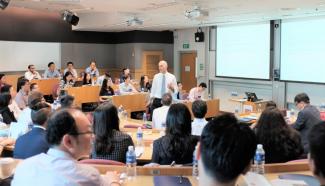
Measures of profitability should ideally be both rooted in theory and backed by empirical data, said Professor John Core, keynote speaker at the SMU SOAR Accounting Symposium 2017.
Above: Professor John Core, Professor of Accounting at the Massachusetts Institute of Technology's Sloan School of Management
By Rebecca Tan
SMU Office of Research & Tech Transfer – While hype and marketing may drive up stock prices, the ability of a company to yield a profit ultimately determines its long-term survival on the stock market. Given the importance of profitability, it is no surprise that accurately measuring past profits and projecting future profits are areas of intense research in business and finance.
One of the basic tenets of investing is that high-risk investments should give high returns. For example, the long-term returns from investing in the stock market should be higher than the returns from investing in less risky bonds.
This investment theory is captured in the capital asset pricing model (CAPM), a model first proposed about 50 years ago that attempts to explain the relationship between risk and return. Despite its firm theoretical grounding, however, the CAPM does not seem to bear out in reality.
“The CAPM or beta model is a nice model to teach graduate students, but there’s very little empirical evidence in favour of it,” said Professor John E. Core, keynote speaker at the Singapore Management University (SMU) School of Accounting Research (SOAR) Accounting Symposium held on 13 December 2017. Professor Core is a Professor of Accounting at the Massachusetts Institute of Technology’s Sloan School of Management.
Do profits make more profits?
To improve the accuracy of CAPM, researchers like Professors Eugene Fama of the University of Chicago Booth School of Business and Kenneth French of Dartmouth College have introduced factors other than risk to predict expected returns. In 1993, they proposed the Fama-French three factor model, which uses empirical data on market risk, company size and book-to-market ratio to estimate expected returns.
“For a long time, size and book-to-market ratio were thought to be anomalies, but the Fama-French three factor model, which has been the dominant paradigm for the last 25 years, has adopted them as factors that are useful for explaining future returns,” Professor Core explained.
More recently, Professors Fama and French have further extended their model by including two additional factors: Profitability and investment. Leaving investment aside, the Fama-French five factor model predicts that higher-profit firms will have higher stock market returns.
Although the Fama-French three and five factor models both predict expected profitability better than CAPM, they are empirically driven and not based on theory, Professor Core said.
“These models identify factors that do a good job of explaining returns in most situations, but they do not explain why they do,” he continued. “There’s no theory that suggests that these are risk factors that cause returns to be high, but according to Fama and French, their model provides exposure to an unknown mass of state variables and gives us a framework to suggest what the factors are.”
Theory that matches the data
One proxy for future returns that accountants use as an alternative to the Fama-French models is the implied cost of capital (ICC). Similar to the Fama-French models, ICC includes the current profitability as a predictor of future profitability. However, the ICC has a stronger theoretical foundation as it is based on the discounted cash flow valuation model.
While ICC has an intuitive appeal, it too has its limitations. The main drawback of ICC as a proxy for future returns is that it is calculated based on earnings forecasted by financial analysts, which are known to be biased and noisy.
Instead of using analyst forecasts, researchers like Professor Hou Kewei at the Ohio State University Fisher College of Business have developed mechanical models that can calculate ICC in an unbiased way.
“In a 2012 paper, Hou and colleagues use their mechanical model to calculate ICC and see if it predicts future returns. What they found was that the model ICC does very well, outperforming the analyst-based ICC,” Professor Core said.
“I think that people on both sides – accounting researchers using ICC and finance researchers using factor models – have things to learn from each other. If a result is there, you should be able to demonstrate it with both approaches, because there are trade-offs involved with each methodology.”
Turning profits into prestige

Above: Assistant Professor Akash Chattopadhyay, Rotman School of Management at University of Toronto
One of the reasons that measurements of profitability are important is that they can influence the way firms behave, said the next speaker at the symposium, Assistant Professor Akash Chattopadhyay of the Rotman School of Management at the University of Toronto. Specifically, he examined if indexes like the JPX-Nikkei 400 influenced the behaviour of firms at the threshold of inclusion.
Introduced as part of Shinzo Abe’s governance reforms, the JPX-Nikkei 400 is a transparent ranking of the 400 best Japanese firms in terms of profitability, capital efficiency and corporate governance. Professor Chattopadhyay found evidence that the introduction of the JPX-Nikkei 400 caused firms ranked between 300 to 500 – whose efforts were likely to affect their inclusion in the top 400 – to be incentivised to improve their profitability.
Interestingly, he also found that managers did not directly receive a financial benefit for their improved performance; instead, the prestige of being included on the list appears to have been the main motivation.
“Studies like ours inform the growing policy discussions surrounding indexes as a governing mechanism. Our work provides a potentially novel example of how prestige and status could be used to change corporate norms,” Professor Chattopadhyay concluded.
Back to Research@SMU Issue 50
Image credit: Rebecca Tan